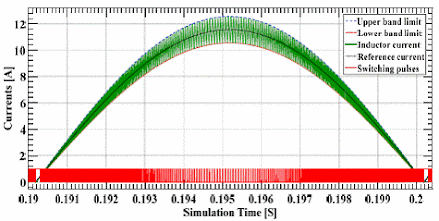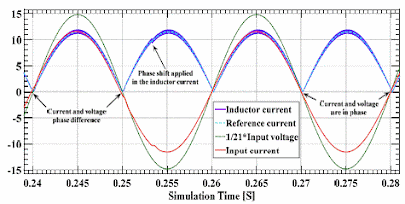ABSTRACT:
This paper presents a two stage battery charger for plug-in
electric vehicles (PEV) based on half-bridge LLC series resonant converter
(SRC) operating at resonance frequency. The first stage is power factor
correction (PFC) stage comprising of boost converter topology using hysteresis
band control of inductor current. The PFC stage reduces the total harmonic distortion
(THD) of the line current for achieving high power factor and regulates the
voltage to follow the battery voltage at DC link capacitor. The input of the
boost converter is a single phase 50 Hz, 220V AC from grid. At the second
stage, a half bridge LLC-SRC is used for constant-current, constant-voltage (CC-CV)
based battery charging and for providing galvanic isolation. The resonant
converter is designed to operate around resonance frequency to have maximum
efficiency and low turnoff current of power switches to reduce switching
losses. The circuit is simulated using MATLAB Simulink with 1.5 kW maximum
output power. Simulation results show that the PFC stage achieves THD less than
0.07% and high power factor value as 0.9976. The DC/DC stage meets all the
CC-CV charging requirements of the battery over wide voltage range 320V—420V for
depleted to fully charged battery.
KEYWORDS:
1.
LLC Resonant
converter
2.
PEV battery
charger
3.
PFC
4.
Hysteresis
band control
5.
FHA
SOFTWARE: MATLAB/SIMULINK
BLOCK DIAGRAM:
Fig.
1. Schematic of the proposed battery charger.
EXPECTED SIMULATION RESULTS:
Fig. 2. Boost inductor current for a half cycle of input voltage.
Fig. 3. AC voltage and current after power factor correction.
Fig. 4. LLC-SRC operating at key point A (V0 = 320V, and I0 = 3.57A).
Fig. 5. LLC-SRC operating at key point B (V0 = 360V, and I0 = 3.57A).
Fig. 6. LLC-SRC operating at key point C (V0 = 420V, and I0 = 3.57A).
Fig. 7. LLC-SRC operating at key point D (V0 = 420V, and I0 = 0.25A).
CONCLUSION:
REFERENCES:
[1]
H. Wang, S. Dusmez, and A. Khaligh, "A novel approach to design EV battery
chargers using SEPIC PFC stage and optimal operating point tracking technique for
LLC converter," Applied Power Electronics Conference and Exposition (APEC),
2014 Twenty-Ninth Annual IEEE, pp.1683-1689, 16-20 March 2014.
[2]
H. Wang, S. Dusmez, and A. Khaligh, "Design and Analysis of a Full-Bridge
LLCBased PEV Charger Optimized for Wide Battery Voltage Range," Vehicular
Technology, IEEE Transactions on, Vol. 63, No. 4, pp.1603-1613, May 2014.
[3]
J. Deng, S. Li, S. Hu, C.C. Mi, and R. Ma, "Design Methodology of LLC
Resonant Converters for Electric Vehicle Battery Chargers," Vehicular
Technology, IEEE Transactions on, Vol. 63, No. 4, pp.1581-1592, May 2014.
[4]
Marian K. Kazimierczuk, "Pulse-width Modulated DC-DC Power
Converters," Ohio, USA: John Wiley & Sons Ltd, pp. 129-134, 2008.
[5]
H. Wang, and A. Khaligh, "Comprehensive Topological Analyses of Isolated Resonant
Converters in PEV Battery Charging Applications," Transportation Electrification
Conference and Expo (ITEC), 2013 IEEE, pp.1-7, 16-19 June 2013.






